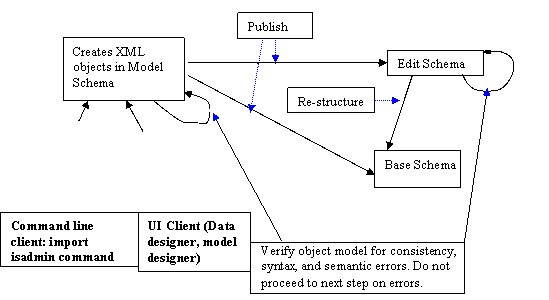 To use isadmin commands in Integrated Operational Planning:
To use isadmin commands in Integrated Operational Planning:
Install Integrated Operational Planning, set up the database, modify the properties, and set up PATH and other environment variables.
See the Integrated Operational Planning Installation Guide for details.
Ensure that the server is not running; then, in a DOS window, enter isreset.
Isreset drops all internal tables and model information, and creates the internal tables again. There is no model at this time.
Open another DOS window and enter initializesystem.bat.
This action initializes the objects needed to build a model.
Use the Administration Workbench to build a model.
Figure 11, Flow for Building a Model shows the flow that happens in the system.
The objects created in the Administration Workbench are stored in the Model schema. You can verify errors, fix issues, and publish the objects for analysis. Integrated Operational Planning stores the models in the database, where they are available between server starts.
Optional. Export model information to the file system.
Reasons to export model information:
Moving the implementation from one computer to another (for example, from development to a test or production computer)
Accessing model objects in XML form when writing scripts
To export model information to the file system, use the isadmin command export model definitions. The objects are exported to install-root/export and various sub-directories.
See XML Files and Search Path.
Integrated Operational Planning also exports an isa file that contains import statements for modeling objects in the system. The objects and isa file reset the system and use scripts to recreate the model.
Copy the subdirectories under install-root/export to install-root/custom.
The export directory is used only for storing the exported files. You can make incremental changes in the custom directory and write scripts to import the changes back to the system. After the model is imported back to the system, use the Administration Workbench to verify the model and make more changes if needed.
Repeat incremental model building by following step 5, step 6, and step 7.
